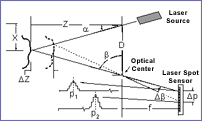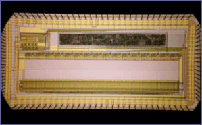|
|

| Français | Contact Us | Help | Search | Canada Site | ||||
| Home | About Us | Publications | Careers | NRC Site | ||||
| Research | People | Collaborations | Locations | What's New | ||||
| Printable version |
3D Technologies
VLSI CMOS Sensors
The Visual Information Technology group (VIT) of NRC-IIT conducts ongoing work in developing technology that advances the field of visual information. The VLSI-CMOS sensor project develops new digital 3D imaging technology for measuring the position of a laser beam in the process of capturing a 3D surface map. Prototypes developed for this project combine:
- A widely used type of semiconductor technology, Complementary Metal Oxide Semiconductor (CMOS)
- Very Large-Scale Integration (VSLI), the process where hundreds of thousands of electronic components are placed on a single chip.
The miniaturization made possible by VLSI technology allows for systems with increased performance, accessibility, and, lower maintenance, size and cost.
This project aims to design optimized position sensors that are based on commercial silicon technology. Current position sensors are not appropriate and cost effective for high-resolution laser scanners used in digital 3D imaging. They are intended for 2D imaging applications in other fields, and their specifications change according to the evolution of their respective fields and not to the requirements of digital 3D imaging.
Combined capabilities of hybrid prototype solutions
The two prototypes developed are for position sensitive detectors, or position sensors (PS), that are used to detect angles when a laser spot is scanned onto a surface and measured using optical triangulation. Two main types of sensors are generally used to accomplish position detection, one type noted for its accuracy and the other for its high measurement speed.
 Laser-based optical triangulation - Click for full view |
The project’s prototypes are hybrid solutions that will be an integral part of future intelligent digitizers able to measure registered color (reflectance) and 3D coordinates both accurately and at a high data rate.
The first prototype, the Colorange sensor, uses continuous response position sensors (CRPS). The second and preferred prototype, the ColorSens sensor, uses discrete response position sensors (DRPS).
 Die photograph of the ColorSens chip - Click for full view |
While CRPS provides speed, project researchers found a way to increase performance using the more accurate DRPS by doubling the DRPS sensors on the same chip, with each sensor filling a different function. The first sensor calculates a raw estimate of the spot position, while the second sensor calculates the spot position with higher accuracy on the basis of information passed on by the first DRPS. Using two of the same type of sensors means that they are suitable for integration on the same chip using the same process. This greatly reduces production and alignment costs.
Advantages of using commercial silicon technology
Using commercial silicon technology in the next stage of development of optical sensors for 3D imaging technology takes advantage of current opportunities in the field:
- Optical sensors produced with CMOS technology have reached a high level of development and reliability that is suited for high accuracy 3D vision systems.
- Low cost CMOS technology is the current leader in the development of competitive optical sensors.
- The availability of standard fabrication technologies and the acquired know-how in the design techniques allow the implementation of optical sensors that are application specific.
- Opto-ASICs, or Application Specific Integrated Circuits (chips designed for a specific application), can be constructed from a library of already-existing circuit building blocks, rather than completely redesigned for each new application.
Integration of most low level processing steps on a chip using advances in VLSI CMOS will allow digital 3D imaging technology to become widely accepted and accessible to universities, research labs, industries, and individual use in such fields as visual communication, heritage documentation, and industrial automation.
This research project is conducted in collaboration with the Istituto per la Ricerca Scientifica e Technologica of Trento, Italy, ITC-Irst, as part of their Integrated optical sensors project.
Related NRC-IIT PublicationsResearch Contact
Jean-Angelo Beraldin (Angelo)
Research Officer
Visual Information Technology
NRC Institute for Information Technology
1200 Montreal Road
Building M-50, Room 352
Ottawa, ON K1A 0R6
Telephone: +1 (613) 990-6871
Fax: +1 (613) 952-0215
E-mail: Jean-Angelo.Beraldin@nrc-cnrc.gc.ca
Business Contact
Charles Gauthier
Business Development Officer
Business Development Office, NCR
NRC Institute for Information Technology
1200 Montreal Road
Ottawa, ON K1A 0R6
Telephone: +1 (613) 993-2491
Fax: +1 (613) 952-7998
E-mail: Charles Gauthier

|
Date Published: 2004-02-10
|
Top of Page | |
